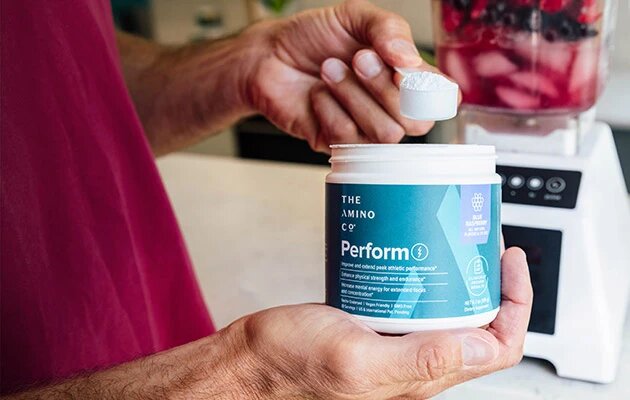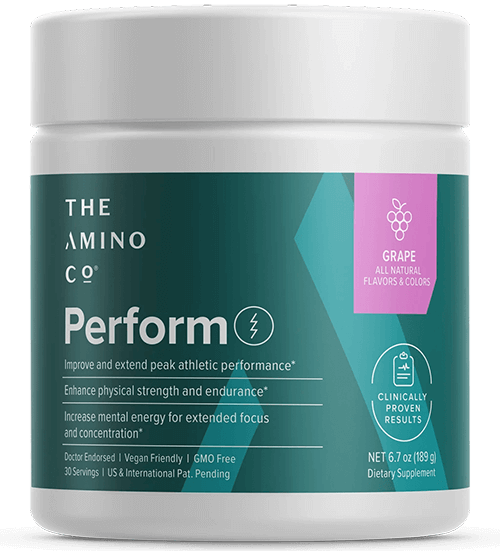The Secret Weapon for Hip Fracture Surgery Recovery
 By: by Amino Science
By: by Amino Science

A hip fracture is a serious injury that cannot be ignored or “managed.” Surgery is the most common treatment for a break in the upper thigh bone, or femur. Hip fracture surgery stabilizes the bone, which helps to prevent future injuries and keeps the bone in place so that the fractured leg is able to heal properly.
Still, recovery from a broken hip is long and arduous, and rehabilitation outcomes are grim, especially among older patients. According to the most recent reports, the first year after hip fracture is the most critical, with a 1-year mortality rate of 14-58%.
Fortunately, advancements in surgical techniques, rehabilitation procedures, and nutritional therapeutics are proving to significantly benefit hip fracture recovery. In fact, there is one therapeutic that can dramatically reduce inflammation, soreness, and pain, and accelerate recovery of hip-joint function so that patients young and old can get back to daily activities sooner.
Risk Factors and Symptoms of Hip Fractures
Your risk of hip fracture escalates with age. People over 65 are at greater risk, as are women, who are 3 times more likely to experience a hip fracture than men.
Conditions such as osteoporosis, which results in a gradual weakening of the bones, increase your risk of falls and fractures, as do other chronic medical conditions, including:
These conditions can impair nutrient absorption and contribute to brittle bones. They can also throw off your balance and increase your risk of falling, as can certain medications, low blood sugar or blood pressure, and tobacco and alcohol use.
A hip fracture won’t go unnoticed. Symptoms include:
- Intense groin or hip pain
- Inability to walk or move
- Inability to put weight on the affected side
- Bruising and swelling
- A shorter leg on the affected side
- Outward turning of the leg of the affected hip
Do not ignore these signs! Doing so can reduce your quality of life and independence and increase your risk of life-threatening complications:
- Blood clots
- Urinary tract infections
- Pneumonia
- Extreme muscle mass loss
- Death
Types of Hip Fractures and Surgeries
Most hip fractures occur as one of two types and can be identified with an X-ray.
- Femoral neck fracture: A break in the upper portion of the femur (1-2 inches from the ball and socket joint) that is commonly attributed to osteoporosis in older adults. This type of hip fracture can cut off blood supply to the top of the femur.
- Intertrochanteric fracture: A break further down the hip joint (3-4 inches) that does not impair blood supply and is often easier to correct.

The type of surgery depends on the nature and severity of the fracture, as well as any underlying health conditions.
- Hip repair (internal fixation): When bone fractures can be properly aligned, an orthopedic surgeon will likely recommend internal fracture repair (hip pinning) with screws in one of two ways. Either metal screws are affixed to bone to hold it together during the healing process or they are inserted into a metal plate that runs the length of the thigh bone.
- Partial hip replacement: Recommended for older people who do not live on their own or have other high-risk health conditions such as dementia, a partial hip replacement involves replacing the femoral head or neck of the femur with a metal prostheses.
- Total hip replacement: A more effective long-term solution, total hip replacement (hemiarthroplasty) replaces the upper femur and pelvic bone socket with artificial components.
Hip Fracture Surgery Recovery
With a total rehabilitation time of 1 year, a return to work estimate of 4 weeks to 4 months, and a possibility of 3 months in a rehab facility, recovery from hip replacement surgery takes patience and dedicated commitment to the follow-up rehab program developed by your health care team.
After your surgery, expect to spend up to a week recovering in the hospital, where you’ll be given pain medications, blood thinners to prevent blood clots, stroke, pulmonary embolism, or thrombophlebitis, and begin your rehabilitation. You’ll likely be given compression stockings or a compression pump for blood clotting, as well as a urinary catheter until you are able to get in and out of bed to go to the bathroom.
You’ll start with breathing exercises to prevent lung congestion that can develop from low activity levels. You will also start moving your foot and ankle to increase blood flow, and will be asked to stand with the help of a walker or nurse within the first 24 hours of surgery. A physical therapist will work with you to find the correct position for your hip and will teach you gentle exercises and how to walk with crutches or a walker.
Recovery from hip fracture surgery cannot be done on your own. You will need help cooking, bathing, and, depending on your age and any mental health conditions, taking your medications and sticking with your rehabilitation program. Full recovery may depend on convalescing at a rehab care facility as you follow your rehab protocol and ultimately recover faster and stronger.
Physical therapy activities will include a combination of weight-bearing activities (walking on a treadmill at various speeds and inclines), non-weight-bearing exercises (swimming or cycling), and strength and balance conditioning to increase bone density.
The Secret Rehab Weapon
Your body needs a steady supply of inflammation-fighting and bone-building nutrients after hip fracture surgery. These include omega-3s, calcium, protein, magnesium, phosphorus, vitamin D, and potassium.
But there’s one nutrient that is often neglected in the weeks and months after surgery—protein, specifically essential amino acids, the nutrients that make up the protein in our bodies—bone, tissues, and muscles!
Essential amino acids can help improve overall health and rehabilitation outcomes in hip replacement patients in several ways. Supplementing helps to improve levels of circulating amino acids, increases the strength and muscle mass of the operated hip joint even in the presence of inflammation, and reduces muscle weakness and soreness, a benefit that can help keep patients on track with physical therapy and accelerate recovery (1).
Research also shows that essential amino acids can help improve walking ability in patients who have had hip fracture surgery.
A recent study showed that only half of patients who have hip fracture surgery regain the ability to walk after 6 months (2). The inability to walk greatly reduces quality of life and increases the risk of mortality. Nutritional intervention with an essential amino acid supplement after hip fracture surgery has been proven to help increase walking recovery rate, thereby improving rehabilitation outcomes and lowering medical costs.
Low albumin levels and anemia are two common conditions that slow recovery and impact quality of life in elderly patients with hip fractures. Taking essential amino acids has also been shown to help bring albumin levels back to normal and reverse anemia in hip fracture patients, thereby improving overall recovery outcomes and increasing the likelihood that patients can reclaim their independence (3).
So how do you get this secret weapon? Amino Company scientists have patented the essential amino acid formula responsible for these recovery gains. We call it Heal, and it’s finally available to all hip fracture patients. You can learn more and purchase it here.


Up to 25% off Amino
Shop NowTAGS: #surgery
Join the Community
Comments (0)
Most Craveable Recipes





 833-264-6620
833-264-6620



















